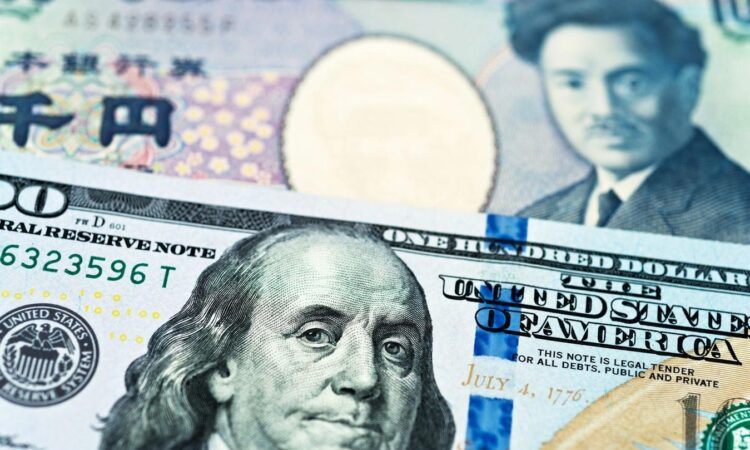
US dollars and Japanese currency background
getty
This issue is being raised as the dollar has surged against key Asian currencies in the past two months: The Japanese yen has weakened to its lowest level in 34 years (see chart), while the South Korean won has slipped to an 18-month low and the Chinese renminbi to a six-month low. When the yen sank to Y160 per dollar at the start of this week, it rebounded quickly and currency traders suspect the Bank of Japan intervened to bolster it.
Figure 1. Japanese Yen Weakens to 34 Year Low versus the Dollar
Japanese Yen to USD Spot Exchange Rate
Board of Governors of the Federal Reserve System (US)
Previously, global investors viewed yen weakness favorably because it helped end three decades of price deflation in Japan. It also improved the competitiveness of Japanese exporters and contributed to Japan’s stock market surging to a record high (see chart).
Figure 2. Japan’s Stock Market Sets a New Record High
Nikkei Industry Research Institute
FRED
Japan’s policymakers, however, have become wary that further rapid depreciation of the yen could cause inflation to rise beyond the 2 percent rate that the Bank of Japan is targeting. The currency has struggled to gain traction even as the Bank of Japan ended its zero interest-rate policy in March, because it has been reluctant to normalize interest rates.
Meanwhile, officials of the U.S., Japan and South Korea issued a rare joint statement on the pressures facing Asian currencies during the recent IMF-World Bank meetings.
According to a CNBC report, authorities in Japan and Korea have called declines in their currencies “excessive.” U.S. Treasury officials reportedly have agreed to “consult closely on foreign exchange market developments,” which has fueled talk that the three central banks might pursue coordinated intervention to stabilize the yen and the won by selling dollars.
These concerns, however, raise several questions. First, does the strong dollar-weak yen pose a genuine problem for the U.S. and Japan? Second, can coordinated intervention halt the slide of the yen and other Asian currencies?
Former President Donald Trump recently weighed in on the economic consequences of a strong dollar. According to a report in The Hill, Trump lamented the yen’s weakness on his Truth Social platform and discouraged the practice of countries deflating their currencies, stating: “When I was President, I spent a good deal of time telling Japan and China, in particular, you can’t do that.”
Trump’s assertion that the Japanese government is responsible for the yen’s weakness dates back to the 1980s, when he believed Japan was taking advantage of the U.S. At that time, Japan ran record trade surpluses and Japanese investors re-invested the export proceeds to purchase U.S. bonds, which had much higher yields than Japanese bonds.
This contributed to a strong dollar that fueled trade frictions between the two countries. It culminated with the signing of the Plaza Accord in 1985, in which central banks agreed to coordinate currency intervention to weaken the dollar.
A key difference today is that the weakness of the yen and other Asian currencies is not the result of Japan and other Asian countries manipulating their currencies. If they were doing so, their foreign exchange reserves would be increasing as they purchased dollars.
But this is not the case for Japan and China: Their holdings of foreign exchange reserves have fluctuated in relatively narrow bands since the middle of the last decade. This partly stems from the U.S. government monitoring their FX holdings closely.
Rather, the main reason that the yen and other Asian currencies have weakened recently is there has been a sea-change in investors’ expectations about Fed policy.
At the start of this year, the Federal Reserve was expected to ease monetary policy significantly and the consensus view among currency analysts was that the dollar would weaken against the yen. However, ten-year Treasury bond yields have surged by 75 basis points recently as investors have dialed back prospective interest rate cuts from six to either one or none. Consequently, interest rate differentials now favor the dollar by substantial margins – 5.5 percentage points for 3-month instruments and 3.7 percentage points for 10-year yields.
Dollar strength is not viewed as a problem by the Fed, because it keeps import prices low and thereby lessens inflation pressures. However, it could become a problem for the U.S. government if it caused the U.S. current account deficit to widen materially and fueled protectionist pressures.
Looking ahead, central banks could try to bolster the yen and other Asian currencies by selling dollars in currency markets. It is doubtful this would succeed, however, as long as the Fed refrains from easing monetary policy and the sizable interest-rate differentials favoring the dollar persist.
Meanwhile, most Bank of Japan watchers expect it will raise its key policy rate only gradually with the economy softer-than-expected. In this regard, BOJ Governor Kazuo Ueda told parliament that the central bank would consider raising interest rates if trend inflation accelerates toward its 2% target from the current pace of 1.3% in March. However, economists polled in a Reuters survey do not expect the next rate hike until late this year.
Finally, even if central bank intervention does not alter the dollar’s trajectory, it might achieve one purpose. Namely, it would demonstrate that the Bank of Japan and other Asian central banks are not manipulating their currencies to gain a competitive advantage. Considering the growing threat of protectionism in the U.S. today, it could help counter assertions about unfair practices of foreign governments.



